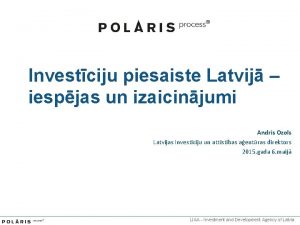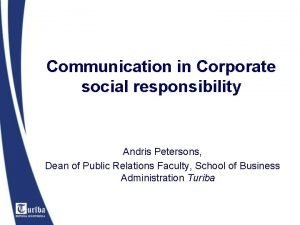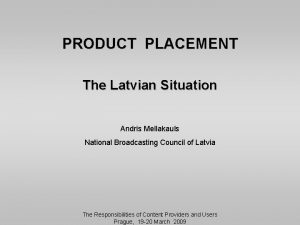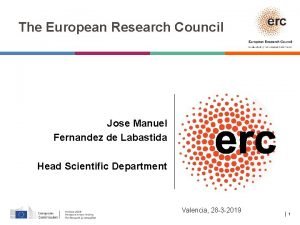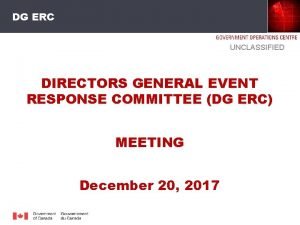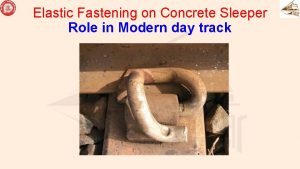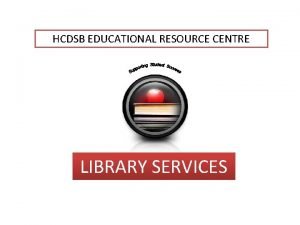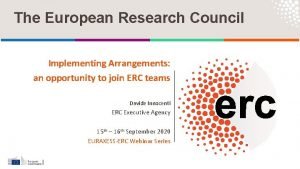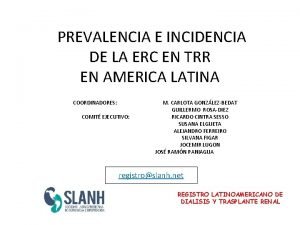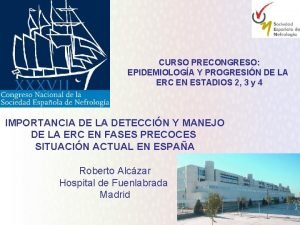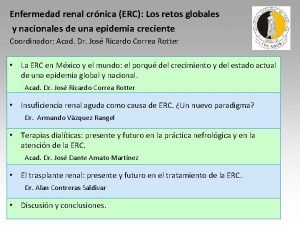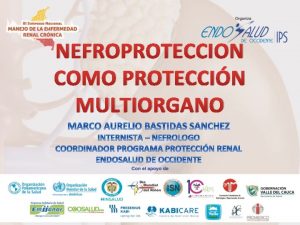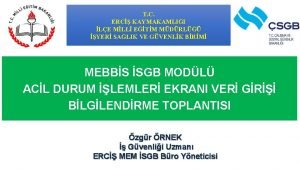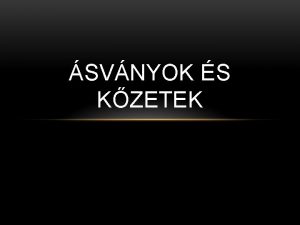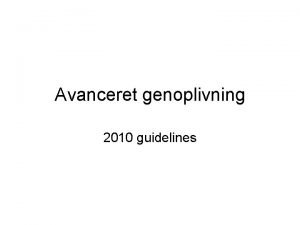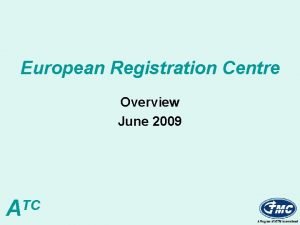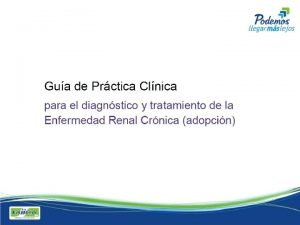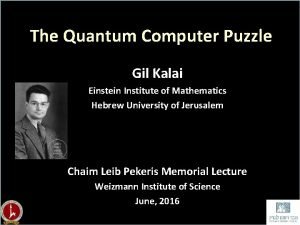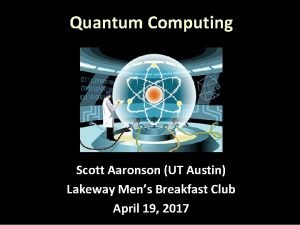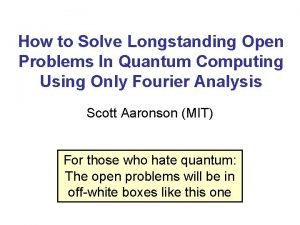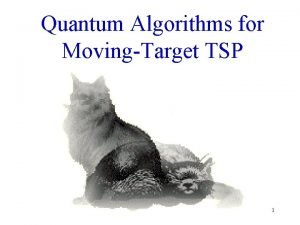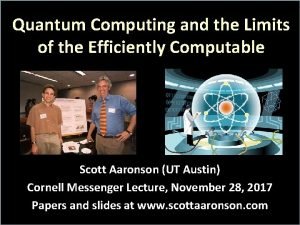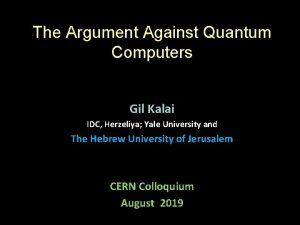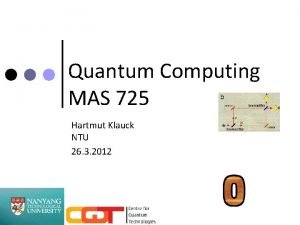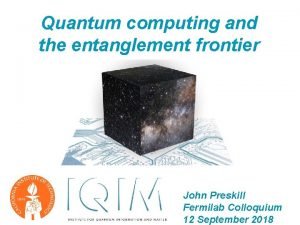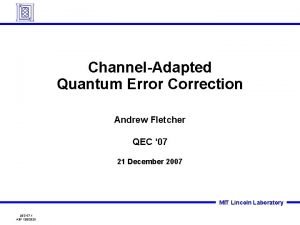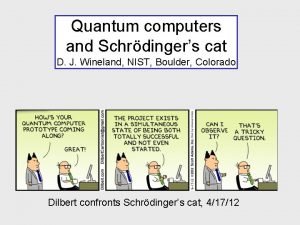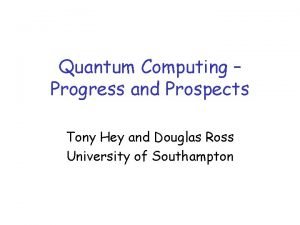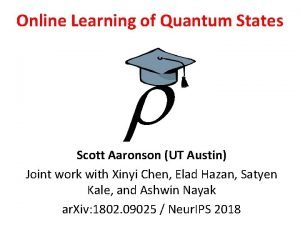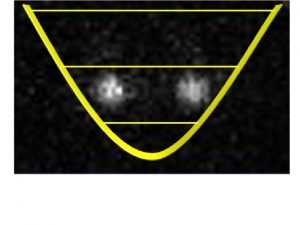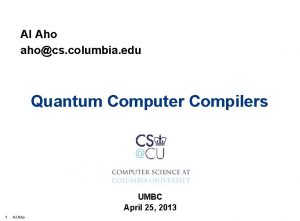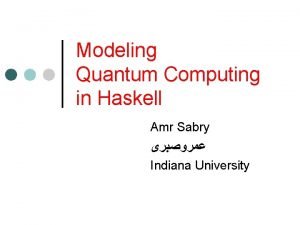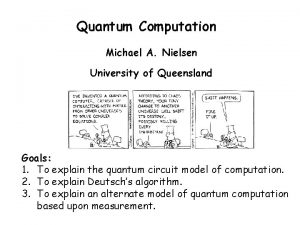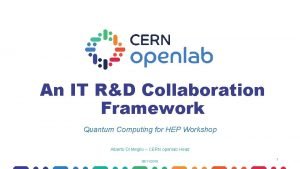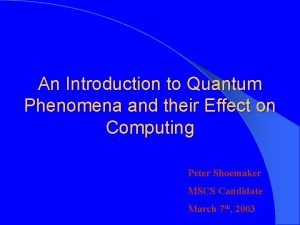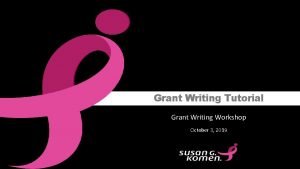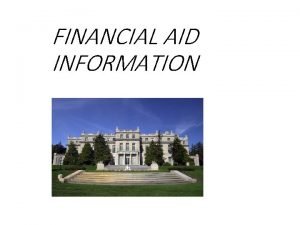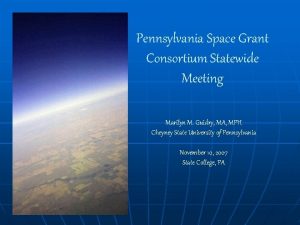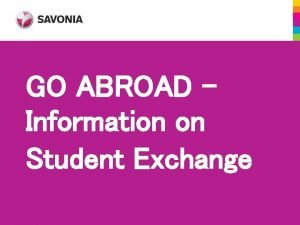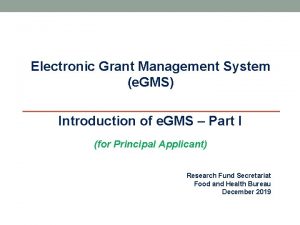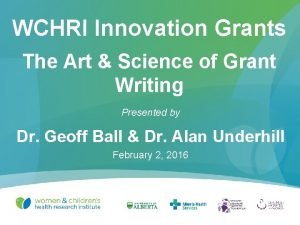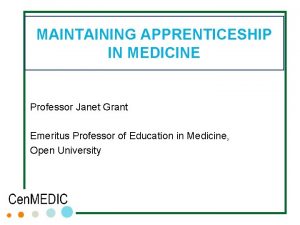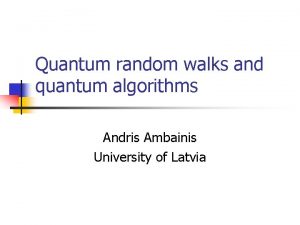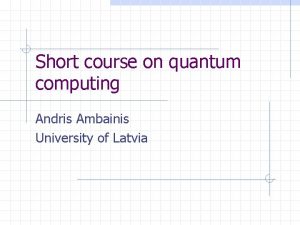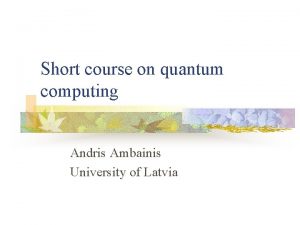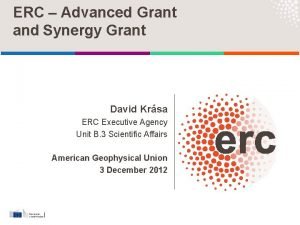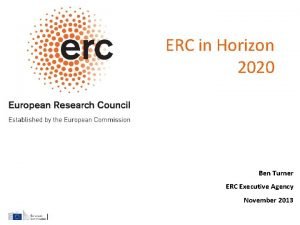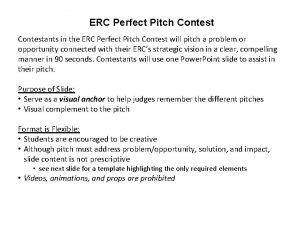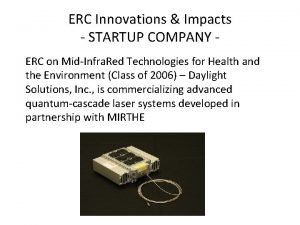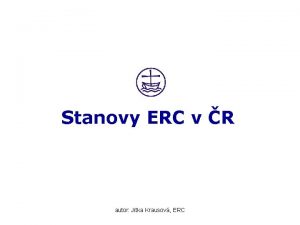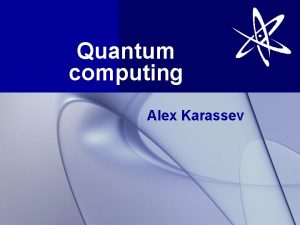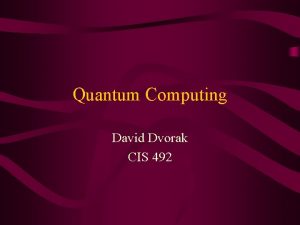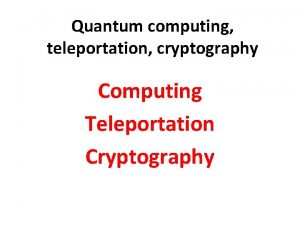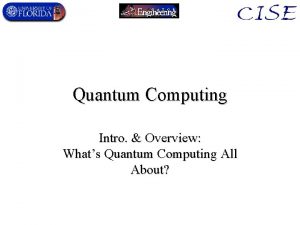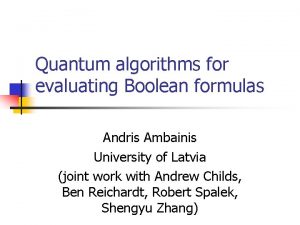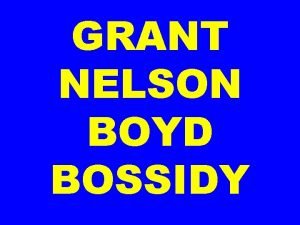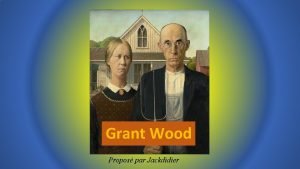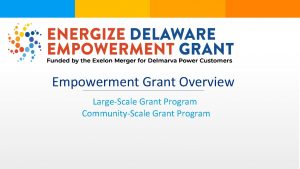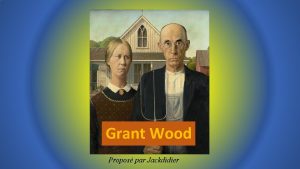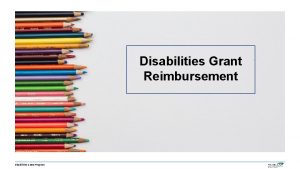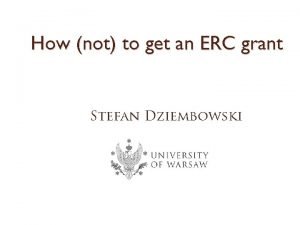Experience with my ERC grant quantum computing Andris














![[Aaronson, A, 2015] [Aaronson, A, 2015]](https://slidetodoc.com/presentation_image_h/e674f59ecbd240a2545242aa9082a228/image-15.jpg)





































- Slides: 52

Experience with my ERC grant: quantum computing Andris Ambainis University of Latvia

Small scale quantum computers Google, 72 qubits Intel, 49 qubits IBM, 50 qubits

Other Quantum computing efforts

What can we do with a quantum computer when we build it?

Quantum chemistry A substantial application for HPC

Factoring 6231540623 = 93599 * 66577. Given 6231540623, find factors? For large (300 digit) numbers conventional computers are too slow. Shor, 1994: quantum computers can factor large numbers efficiently.

Implications § RSA and other cryptosystems based on factoring/discrete log broken by quantum computers. § Quantum algorithms for other crypto-related problems: § Pell’s equation [Hallgren, 2002], § ideal class group [Biasse, Song, 2016], § principal ideal problem [Hallgren, 2002, Biasse, Song, 2016].

Quantum search ? ? . . . ? § N objects; § Find an object with a certain property. Grover, 1996: O(√N) quantum steps.

My research on quantum algorithms

28 12 18 76 96 82 94 99 21 78 88 93 39 44 64 32 99 70 18 94 82 92 64 95 46 53 16 35 42 72 31 40 75 71 93 32 47 11 70 37 78 79 36 63 40 69 92 71 28 85 41 80 10 52 63 88 57 43 84 67 57 31 98 39 65 74 24 90 26 83 60 91 27 96 35 20 26 52 95 65 66 97 54 30 62 79 33 84 50 38 Task: find two equal 49 20 47 24 54 48 98 23 41 16 66 75 38 13 58 56 86 34 73 61 73 21 44 62 34 14 51 74 76 83 numbers 37 90 58 13 10 25 29 25 56 68 12 11 51 23 77 68 72 43 69 46 87 97 45 59 14 30 19 81 81 49 60 85 80 50 61 59 89 67 89 29 86 48 22 15 17 55 36 27 42 55 77 19 45 15 53 22 91 87 17 33

31 40 75 71 93 32 47 11 70 37 78 79 36 63 40 48 98 23 41 16 66 75 38 27 42 55 77 19 45 15 53 22 91 37 90 58 13 10 25 29 25 56 68 12 11 51 23 77 15 17 § Usual algorithms: N steps. § Quantum algorithms (A, 2004): ~N 2/3. 1, 000 vs. 10, 000

Search by quantum walk Random walk with T steps 1 3 2 4 5 6 [Szegedy, 2004] Quantum walk with O( T) steps

Models of computation Deterministic Probabilistic | Quantum

Query algorithms Task: compute f(x 1, . . . , x. N). Input data xi accessible via queries. Complexity = number of queries.
![Aaronson A 2015 [Aaronson, A, 2015]](https://slidetodoc.com/presentation_image_h/e674f59ecbd240a2545242aa9082a228/image-15.jpg)
[Aaronson, A, 2015]

Quantum attacks on classical crypto Security based on hard problems (factoring/discrete logarithm/etc. ). Some of those problems are not hard for quantum computers. [A, Rosmanis, Unruh, 2014] Quantum attack against security proofs. Breaks some classical protocols even if they use quantumly hard problems.

My career path

University of Latvia (1992 -1997) University of Latvia (2007 -) UC Berkeley (1997 -2001) IAS, Princeton (2001 -2004) U. of Waterloo (2004 -2007)

My undergraduate research Inductive inference; Very abstract mathematical theory of learning; Invented in 1960 s, gradually replaced by modern theories from 1980 s, still done at U. of Latvia in 1990 s. No relation to quantum computing

Vazirani group (Berkeley) Umesh Vazirani Ashwin Nayak Amnon Ta-Shma. .

Experience at Berkeley First learned about quantum computing at U. of Latvia in 1993. Started actively doing research in quantum computing at UC Berkeley in 1997. «Lab know-how» matters, even in mathematics

Next turning point – return to Latvia

Steps toward the ERC 1. Quantum Algorithms and Quantum Computing (QAQC), Marie Curie IRG, 20082012. 2. Datorzinātnes lietojumi un tās saiknes ar kvantu fiziku, EU structural funds grant, 20092012. 3. Quantum Computer Science (QCS), FETOpen, 2010 -2013.

Latvian structural funds project December 1, 2009 – November 30, 2010. Large, interdisciplinary: quantum computing, quantum physics, software science. 28 researchers, including 6 in my group. My first major research project.

QCS project Coordinator: University of Latvia. 8 partners, 7 countries. Cambridge Rīga Amsterdam Brussels Paris

My ERC project – Methods for Quantum Computing

MQC – Methods for Quantum Computing ERC Advanced Grant 2012. May 2013 – April 2018. PE 6 – Computer Science and Informatics.

MQC – Methods for Quantum Computing Focus on central questions: Developing new quantum algorithms; Bounding the maximum quantum advantage; Interdisciplinary connections: Classical computer science; Quantum physics. Several relatively independent lines of research with a common theme.

Part 1 – new quantum algorithms Developing new quantum algorithms via a variety of approaches: Quantum walks; Span programs; Learning graphs; Solving linear systems of equations; Quantum state transformations. Several approaches developed in the last 3 years before the application.

Quantum advantage over smart search

Backtracking § Sequence of partial solutions. § If stuck, return to previous step. § Applications: AI, optimization, circuit design, etc. Montanaro, 2015, A, Kokainis, 2017: quantum speedup for backtracking.

Quantum backtracking also useful for finding the best move in 2 player games [A, Kokainis, 2016]

Part 2 – structure of quantum algorithms Provable bounds on the biggest possible quantum advantage in a variety of settings: arbitrary functions; total functions; problems with symmetry constraints. Applications to cryptography.

Quantum – classical gaps Gaps between quantum and deterministic query complexity for total f(x 1, . . . , x. N), x 1, . . . , x. N {0, 1}? Biggest known: Q = O( N), D = N [Grover, 1996]. Our result: Better gap between randomized and deterministic complexity (open since 1986).

Part 3 – connections to other fields Mathematics/classical computer science: Using quantum computing as a tool to solve purely classical problems. Quantum physics: Understanding the complexity of computational problems from quantum physics.

Writing the project Time effort: ~100 hours. Used 4 examples of successful ERC proposals. Asked 6 colleagues with different backgrounds for feedback on part A 1. Important to know: how does the proposal look for a colleague from software engineering or scientific computing?

Previous review panel (Ad. G 2010)

Previous review panel (Ad. G 2010) Closest to my research area: Samson Abramsky – semantics of programming languages, unusual form of quantum computing; Nicolo Cesa-Bianchi – computational learning theory; Heikki Maniila – algorithms for processing strings of symbols. researchers on scientific computing (linear algebra on high performance computers). No true expert on quantum computing

Structure of the proposal Big questions: What problems can we solve with a quantum computer? When can we achieve large quantum speedups? How can we use ideas from quantum information to solve problems in other areas? Short proposal: ½ page on why quantum computing is important; ½ page on big questions; 1 page of details on each question. ½ page on impact, collaborations, etc.

My applicant profile Relatively junior for ERC Advanced Grant: 14 years since 1 st Ph. D. (U. of Latvia); 10 years since 2 nd Ph. D. (Berkeley); Several major research contributions: Quantum walks – one of 2 -3 most widely used method for quantum algorithms. Quantum adversary – the most widely used method for proving limits of quantum computers.

Publication record / recognition 18 papers in top theoretical computer science conferences (9 in STOC, 9 in FOCS). Papers in physics journals (including 1 in Physical Review Letters). Invited talks, including: quantum information conferences; tutorial at STOC’ 2004; workshop on US research strategy for quantum information science (2009).

My applicant profile Successful Ad. G applicants often have 10 -20 more years of experience. Citation statistics: H-index (Google Scholar): 30; Typical for successful Ad. G applicants in PE 6: 40 -60. I had no Ph. D. Students graduated in 2012 (several students in progress, including one exceptionally good).

Budget 1. 36 million EUR/5 years; Less than the Ad. G maximum (2. 5 million EUR). Theoretical research requiring no lab equipment. Part of salary for myself and senior researcher. 2 postdocs and 3 graduate students.

ERC review process 8 reviews. Many comments showed detailed knowledge of the field, e. g. : «the PI has just very recently (after the submission of the proposal) solved one of these problems in collaboration with a Dutch researcher employing an interesting idea»

ERC review process Another comment: It is not surprising, that one of the best (or perhaps the very best) young student-scholar who has made a name for himself in the past two years in quantum computing is the PI's student, A. Belovs.

Many ways for a successful ERC proposal One main line of work, addressing a major shortcoming of current methods or Many smaller questions around a common theme.

Impact of ERC grant on my career

Center for Quantum Computer Science Research laboratory at the University of Latvia. 3 faculty members (myself, A. Belovs, J. Smotrovs), 12 postdocs/graduate students. University of Latvia as one of 4 -5 leading centers for quantum computer science in Europe.

Postdocs and students ERC grant has helped attract: 4 postdocs from other countries (Brazil, India, Russia, USA). Best Latvian graduate students.

Students A. Belovs M. Kokainis J. Vihrovs K. Prūsis

Recognition in Latvia 1 st ERC grant in Latvia; Interviews by major Latvian newspapers/magazines. Grand Medal of Latvian Academy of Sciences, 2013.

Questions?
 Andris skuja umd
Andris skuja umd Andris ozols
Andris ozols Andris ambainis
Andris ambainis Andris petersons
Andris petersons Andris mellakauls
Andris mellakauls Classical mechanics
Classical mechanics Quantum physics vs quantum mechanics
Quantum physics vs quantum mechanics Erc funding
Erc funding Dg erc
Dg erc Elastic fastening in railway
Elastic fastening in railway Hcdsb library services
Hcdsb library services Erc funding
Erc funding Erc colombia
Erc colombia Erc
Erc Erc colombia
Erc colombia Erc funding
Erc funding Erc colombia
Erc colombia Tc erc
Tc erc Magmás ércképződés
Magmás ércképződés Als kursus erc
Als kursus erc Functions of erc
Functions of erc Erc
Erc Erc colombia
Erc colombia Gil kalai quantum computing
Gil kalai quantum computing Quantum computing ut austin
Quantum computing ut austin Open problems in quantum computing
Open problems in quantum computing Tsp
Tsp Quantum computing
Quantum computing Gil kalai quantum computing
Gil kalai quantum computing Hartmut klauck
Hartmut klauck Quantum computing and the entanglement frontier
Quantum computing and the entanglement frontier Mit quantum computing
Mit quantum computing Dilbert quantum computing
Dilbert quantum computing Quantum computing progress and prospects
Quantum computing progress and prospects Ashwin nayak
Ashwin nayak Quantum computing prerequisites
Quantum computing prerequisites Mit quantum computing
Mit quantum computing Haskell quantum computing
Haskell quantum computing Michael nielsen quantum
Michael nielsen quantum Cern openlab quantum computing
Cern openlab quantum computing Quantum computing meaning
Quantum computing meaning Experience expectant vs experience dependent
Experience expectant vs experience dependent Continuity vs discontinuity
Continuity vs discontinuity Direct experience vs indirect experience
Direct experience vs indirect experience Conventional computing and intelligent computing
Conventional computing and intelligent computing The street cars are like frosted cakes
The street cars are like frosted cakes Grant writing tutorial
Grant writing tutorial Q college cost
Q college cost Pennsylvania space grant consortium
Pennsylvania space grant consortium Dr savonia grant
Dr savonia grant Electronic grant management system
Electronic grant management system Wchri innovation grant
Wchri innovation grant Professor janet grant
Professor janet grant

